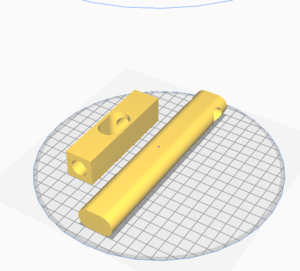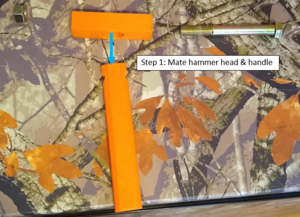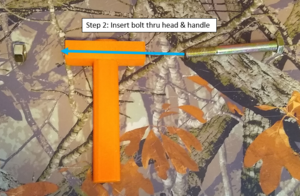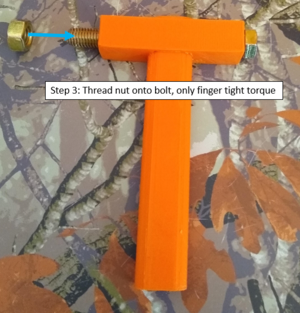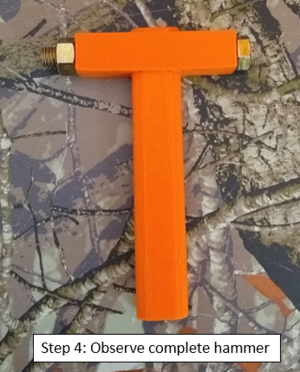
This is an improvement of a previous hammer design, which can be found here
- For the purpose of being an open source appropriate technology, I have identified a few areas the concept of a 3D printable hammer can be improved.
- The most obvious issue with the previous design in regards to appropriate technology, is wasted material. In the realm of appropriate technology, saving material and ultimately money wherever possible is a must, excess material is going to increase cost for no real gains. The previously designed hammer has some aesthetic shaping to it that does not do anything functionally for the purpose of using it as a hammer, and as such I have removed this from my design.
- Additionally, the existing design is not optimally designed for 3D printing. Printing it as one piece vertically results in layers being arranged in a sub-optimal orientation for absorbing the impact of using it as a hammer. Along with this, the reported print times on this design are ~3 times longer than what was necessary for my design.
- The previous design uses a bolt threaded into the plastic, which as stated on the page requires an additional tool in the form of a wrench to install the bolt, and a vise to hold the hammer head to insert the bolt. My design uses a close fit clearance hole with a through bolt to remove the need for additional tools (that may inflate the cost) to assemble it. My reported cost is a worse case scenario of everything needed to assemble the hammer, without needing additional hand tools, a vise, and a bench of some form to secure the vise to.
- The last issue identified with the previous design, was it being impossible to replace parts and lacking modularity in the design. The previous design only allowed for one type/weight of hammer per print, the way my hammer is designed, longer bolts with additional nuts can be used to increase the weight of the hammer without the need to print additional parts, conversely if a lighter hammer is desired a smaller head could be printed to fit the same existing handle instead of printing an entire hammer. On this same idea, it is a 3D printed plastic hammer, in the event of material failure, if a part of my design fails it is possible to only print the broken part, and not require the entire tool be re printed at a higher time/material cost.
In areas of the world with limited manufacturing capabilities and limited monetary resources, coming by basic hand tools can be more difficult than it is here in the US. This specific item is a hammer that can be 3D printed, with a bolt and nut(s) being used to assemble the parts as well as act as the striking surface and add weight to the hammer. Obviously, a fully 3D printed hammer is not a super realistic tool to produce with what is realistically available to most individuals around the world in terms of 3D printing outside of industrial settings. However, with the availability of printers that can at least print in PLA expanding with their costs falling, this is a more realistic way for anyone to produce a hammer.
Outside of being easier to access for resource deprived areas of the world, this could be used by anyone who may want a lot of different size hammers for a low price, I myself am going to be making several as the cost of filament is low, at 71 grams of filament used to produce my first one costing me ~$1.42 US to produce a larger size, using bolts that I already have laying around. With bolts/nuts being an extremely common fastener that literally holds a large part of the world we live in together, they should be fairly easy to come by almost anywhere and the SCAD code is written in terms of variables all commented at the top to allow for extremely easy adjustments of sizing to fit any use case.
This design was kept as simple as possible to ensure any level of printer can produce it with the minimal amount of material usage, reducing the size of the pla head that functionally only needs to locate the bolt also minimizes the change of tool failure due to a missed swing, as the head of the bolt covers most of the hammer head.
- Assembled Hammer & All Parts
-
-
Bill of Materials[edit | edit source]
Source code and original STL's Are here at Thingiverse
- PLA Filament, ~71 grams for the design as posted, this is subject to change based on the size of the hammer being printed, ~$1.42
- 9/16"x5"-12 bolt for the design as drawn, this can be changed to whatever hardware is available with simple edits to variables at the top of the code that are clearly commented. Thread pitch is not important as long as it matches the nut, the hammer is made with a clearance hole to be through bolted. ~$3.41 for a Grade 8 identical to what I used if bought at the inflated price from Mcmaster Carr
- 9/16" nut to match thread pitch of bolt, I assembled mine using a 12 TPI coarse thread as that is what I had on hand, but again the thread pitch is not critical as long as the nut and bolt match ~$0.29 for the 9/16-12 Grade 8 nut I used from McMaster Carr, Grade 8 hardware is honestly more than overkill for this and McMaster carr prices are higher than anywhere else, using this exact hardware configuration is not critical.
Total Printed Part Cost: $1.42
Hardware cost: >$3.70
Total cost to Produce: >$5.12
Once again, this prototype was made using more expensive grade 8 hardware that is more than overkill for this, priced from one of the more expensive places to acquire hardware from, assuming a worst case scenario on cost.
Tools needed[edit | edit source]
- MOST Delta RepRap or similar RepRap 3-D printer
Skills and knowledge needed[edit | edit source]
No special skills are necessary to produce this, as long as any end user can slide similarly shaped solids into similarly shaped holes it is very straight forward.
Technical Specifications and Assembly Instructions[edit | edit source]
Orient the parts as shown if printing both at once is a possibility on your printer to reduce time, the longer flat surfaces should be flat to the bed and the STL's should import in the correct orientation into CURA for printing separately, one part may need to be rotated to print together. It may take ~5.5 hours to print at 60% infill with both parts in one print, this time is subject to change based on final part sizing/infill & etc
In my testing, 30% solid with a grid pattern on the handle and 60% solid with a grid pattern infill on the head appears to work well and reduces time and material cost. Infill settings can be adjusted for the specific end use, with heavier duty use requiring a larger percentage of the part being infilled.
The next series of images contain assembly instructions, the assembly of this tool should be extremely straight forward and simple.
If all goes well, assembly should take less than a minute.
Common Problems and Solutions[edit | edit source]
- A potential issue with this could come down to the clearances necessary for parts to fit. Depending on the accuracy of your printer and quality of filament, these may need to be enlarged if your parts do not fit together. A 1mm clearance allowed for good fitting parts with my hardware and printer but there is a chance this can change, this should be easily adjustable within the code as it was all written with clearly commented variables at the top to control the shape.
- Other than using larger clearances, using abrasive material to shave down the handle or enlarge the slot in the head may work if it is close
- If the hammer head warps or the hole ends up being slightly too tight, rotating the bolt clockwise will allow it to pull itself through using the threads on the bolt. This is intended to be a tight clearance hole but depending on a variety of factors there is the possibility this does not happen with every printer configuration and every set of environmental conditions. I ran into this issue on my first print and with the adjusted clearances this works as intended on my printer configuration and filament.
Cost savings[edit | edit source]
- If your solution is not a low cost one then it is not really appropriate.
- At a worst case scenario in terms of hardware pricing, this would cost ~$5.12 to produce, realistically this number should be lower by sourcing cheaper hardware.
- 8oz Hammer on Amazon for $9.99 [1]
- At the worst case scenario, this would save ~$4.80 over a commercially available option.
- It is worth noting, with this design, the use of a longer bolt and adding extra nuts to the rear will allow for a heavier weight hammer to be produced, in the configuration as posted it weighs ~6.4 oz
- Also worth noting, along with the cost only being roughly a 50% reduction, this is at the worst case pricing for hardware, and assuming the end user of this tool would have access to amazon to order a mass produced hammer and have it delivered for a low price. In more remote areas of the world, the cost of obtaining a hammer will likely not be as low as those with access to companies with enormous warehouses.
Benefited Internet Communities[edit | edit source]
- r/3DPrinting [2]
- Appropedia Users/Organizations Using the list to find OSAT's [3]
- 3DPrinterchat.com [4]
- r/Carpentry [5]
- r/opensourcehardware [6]
- the list can go on for a long time, a hammer is a relatively common tool with a very large array of applications, and a hammer design such as this allows for anyone to easily create a whole set of different weight hammers for a small amount of money to tackle any size job
References[edit | edit source]
- ↑ Web page: Amazon item page for commercially available hammer (2019) Available: https://www.amazon.com/Choice-Stubby-Hammer-Magnetic-Starter/dp/B074D4TDVM/ref=sxin_5_ac_d_rm?ac_md=0-0-aGFtbWVy-ac_d_rm&keywords=hammer&pd_rd_i=B074D4TDVM&pd_rd_r=f9ea0632-dafb-4e36-a399-89d947f4afac&pd_rd_w=tCFo8&pd_rd_wg=ZZN8K&pf_rd_p=6d29ef56-fc35-411a-8a8e-7114f01518f7&pf_rd_r=HHN23TNAHPNBM5HKGTF6&psc=1&qid=1575494062


